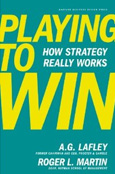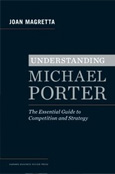April 2013: In This Issue
As the NCAA “March Madness” basketball tournament has proven again this year, no team is safe in a competitive environment. A finely tuned game plan is necessary for success both on the court and in the business world.
This issue of “A New Leaf” deals specifically with the critical area of STRATEGY. Both resources below offer outstanding insights into the theory of STRATEGY and how it has been successfully applied in real life scenarios.
Entering the 2013 second quarter, you should now understand your competitors’ game plan, be revising your own and preparing to “win” during the rest of the year. If you find yourself falling behind, regroup and begin team discussions about what it will take to effectively compete for the rest of the year.
Best of luck in setting the stage for a successful, final three quarters of 2013.
- Mike
 Book Review:“Playing to Win”
Book Review:“Playing to Win”
Is your team “Playing to Win”? Do you know? Have you made conscious decisions as to “where to play” and “how to win”?
“Playing to Win”, co-authored by A.G. Lafley and Roger Martin, provides a clear roadmap for leaders looking to chart a successful organization strategy. As Chairman and CEO of Proctor and Gamble (P&G), Lafley doubled sales, quadrupled profits and increased P&G’s market value by over $100 billion. Its portfolio of billion dollar brands such as Tide, Pampers and Gillette grew from ten to twenty four as he effectively executed a model resulting in sustained business growth. His strategic consultant during this period was Roger Martin, now Dean of the Rotman School of Management at the University of Toronto. In “Playing to Win”, they have collaborated on sharing their playbook successfully implemented at P&G.
“Playing to Win” provides a unique combination of process and practical advice for determining a winning strategy. Lafley complements his strategic model with numerous P&G case studies. These include the successful repositioning of Oil of Olay as a leader in the skin care segment, the unconventional team with a market leading, trash bag competitor through the formation of a technology partnership and the transformation of its failing Gain laundry detergent business to a billion dollar, profitable brand.
The answers to all of the above cases arose from a thoughtful analysis of the following key strategic questions:
*What is our winning aspiration?
*Where will we play?
*How will we win?
*What capabilities must we have in place to win?
*What management systems are required to support our choices?
 Supplemental Book Review:
Supplemental Book Review:
"Understanding Michael Porter"
For the last three decades, Harvard Business Professor Michael Porter’s groundbreaking writings have allowed leaders to understand the theoretical underpinnings of STRATEGY and COMPETITION. His fourteen books, including best sellers “Competitive Strategy” and “Competitive Advantage”, provide enduring models for building a disciplined strategy to achieve superior results.
Joan Magretta, author of “Understanding Michael Porter”, has worked closely with Porter for over twenty years, including her most recent role as senior associate at the Harvard Business School. As a previous Bain Consulting partner, she successfully translated Porter’s highly academic research into successful organizational application. Building upon her personal relationship and business experience, Magretta’s “Understanding Michael Porter” represents a readable and concise summary of Porter’s key works on Competition and Strategy. It provides leaders and managers of all organizations with the models to translate Porter’s theoretical concepts to practical application in their own organizations.
Some of the key take-aways from Porter’s writings include:
*STRATEGY explains how an organization, faced with competition, will achieve superior performance
*Strategic competition is about choosing a path DIFFERENT from that of your competitors. Instead of “competing to be the best”, companies need to compete to be UNIQUE. This concept is all about creating VALUE for the customer.
*The real point of competition is NOT to beat your rivals, but to EARN PROFITS.
*The collective strength of the FIVE COMPETITIVE FORCES impacts the structure of all industries. Each of these forces affects prices, costs and the investment to compete. Industry structure ultimately determines how the economic value created by the industry is divided.
*Having a COMPETITIVE ADVANTAGE means that, compared to your rivals, you operate at a lower cost, command a premium price (through differentiation), or both. It is directly impacted by the ACTIVITIES that your organization chooses to perform.
*A DISTINCTIVE VALUE PROPOSITION answers the following three fundamental questions:
- What CUSTOMERS are you going to serve?
Which NEEDS are you going to meet?
What relative PRICE will provide acceptable VALUE for the customer and acceptable PROFITABILITY for the company?
* An effective strategy affirmatively addresses the following FIVE TESTS:
- A unique value proposition-Are you offering distinctive value to a chosen set of customers at the right relative price?
- A tailored value chain-Is the best set of activities to deliver your value proposition different from the activities performed by rivals?
- Trade-offs different from rivals-Are you clear about what you won’t do so that you can deliver your kind of value most efficiently and effectively?
- Fit across your value chain-Is the value of your activities enhanced by the other activities you perform?
- Continuity over time-Is there enough stability in the core of your strategy to allow your organization to get good at what it does, to foster tailoring, trade-offs, and fit?
Every leader will walk away from “Understanding Michael Porter” with their own list of strategic questions for team follow up. To the extent that you are interested in information beyond that summarized in Magretta’s 200-page summary of Porter’s key concepts, you should explore “Competitive Strategy” and “Competitive Advantage” written by Porter himself. Understanding both will be critical to obtaining superior profitability in today’s dynamic marketplace.
©2013 See Change Management. All Rights Reserved. Site credit


